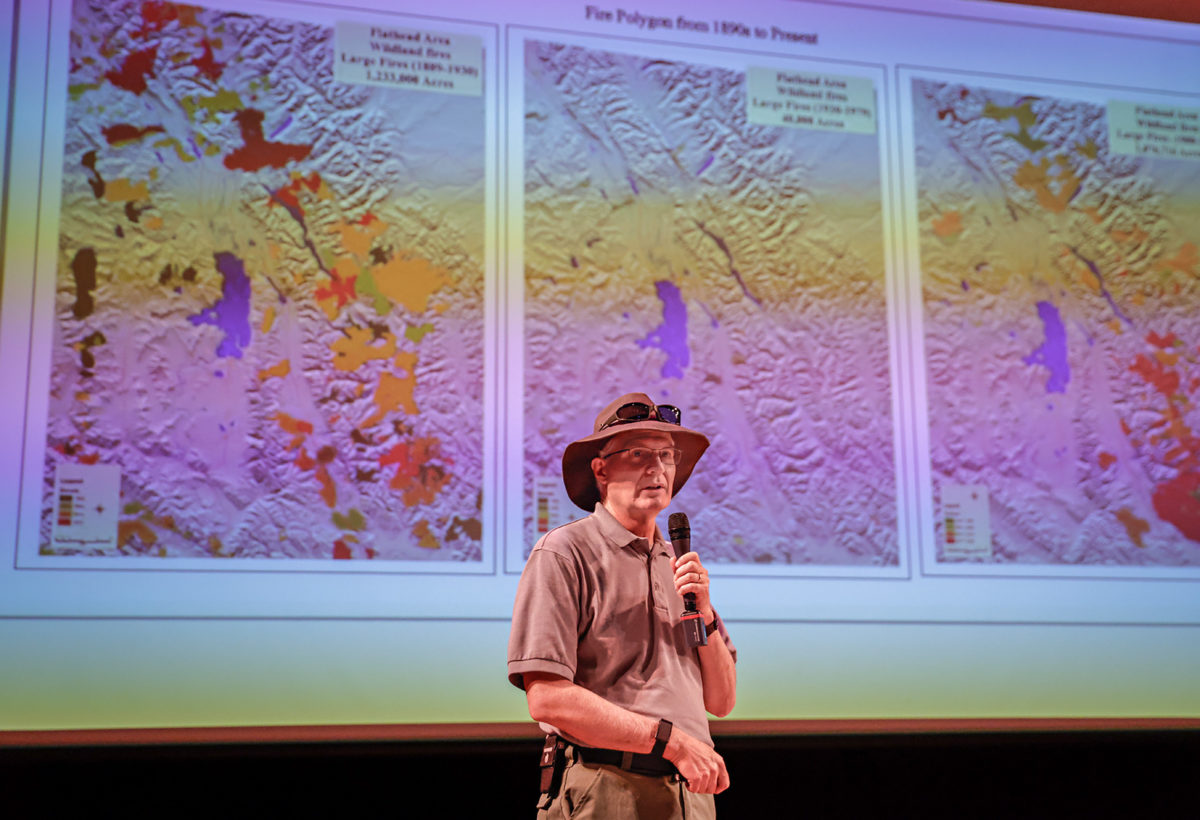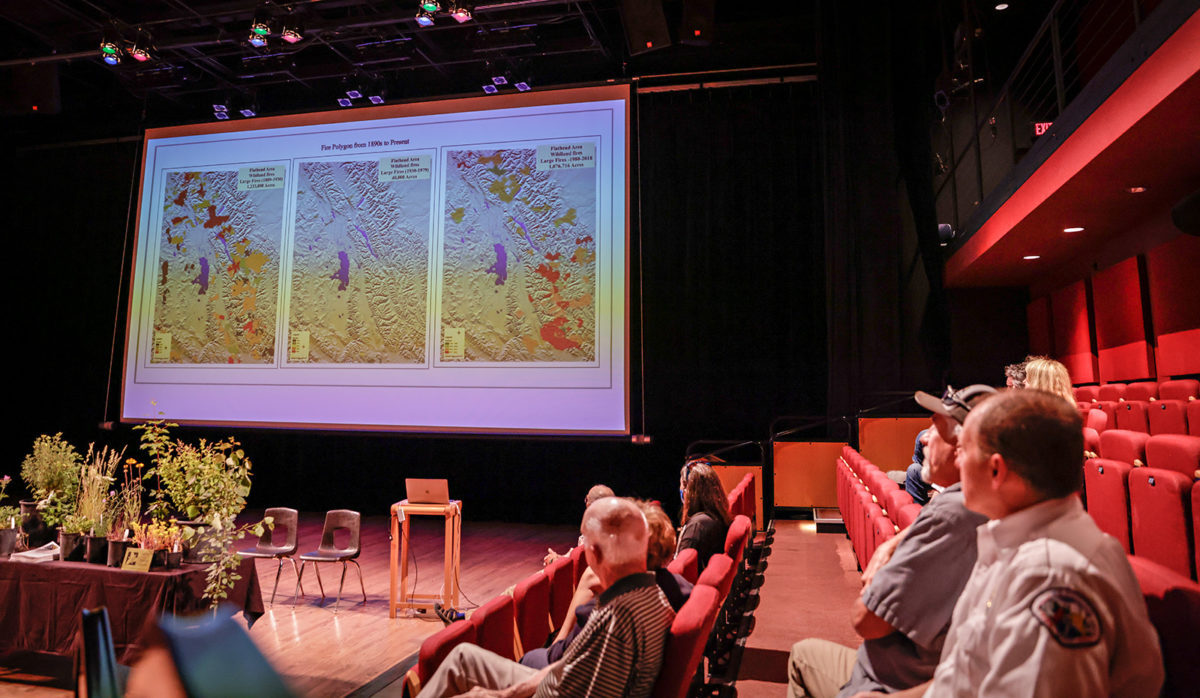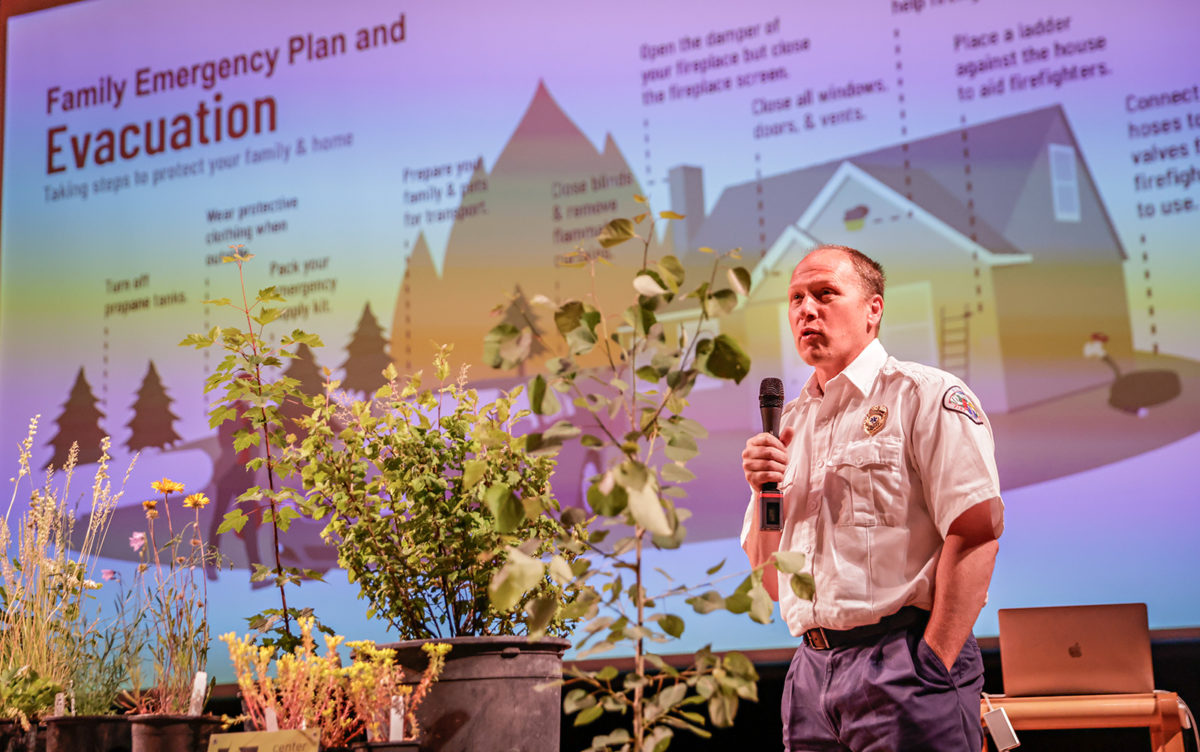Facing the Fire
A recent meeting in Whitefish brought together community members and fire experts to discuss ways to be prepared for wildfire
By Mike Kordenbrock
For Rick Connell, the cool wet days that have marked this spring and early summer in the Flathead Valley don’t merit a sense of complacency surrounding fire season. In Connell’s estimation, the only thing it rules out is an early onset of smoky skies.
From now through September and into October, fire risk will break down along a multitude of factors, with a significant one being whether or not the area sees additional precipitation. Without more rain in the coming weeks, Connell said in one possible scenario the bumper crop of grass produced by recent rainfall could be dried out by the third week of July, which could help fire growth amid dead fuels that are already present.
Connell is a fire, fuels aviation and air staff officer for the Flathead National Forest, and a Type 2 incident commander for the Northern Rockies Team 4. The most recent forecasts for the Flathead show normal potential for significant wildland fires all the way through October. But forecasts and predictions have their limits. Connell pointed out that the same forecast was put forward for Alaska heading into its current fire season. Right now, more than a million acres of land are burning in Alaska, and resources from the Flathead, including the Flathead Hotshots, have been dispatched to Alaska to assist.

The conundrum for fire officials in the region is that often people don’t want to talk, or even think about fire, until fire season is well underway. By that point valuable time has already been wasted that could have otherwise been spent prepping a piece of property to reduce its risk of wildfire ignition. And as Connell noted, strategies to reduce ignition risk on a property benefit not only the property owner but their neighbors, too. If one house ignited in a subdivision, all that heat and burning debris can cause fire to spread from home to home, creating a rolling series of structure fires that might overwhelm limited firefighting resources during a wildfire event.
Population growth in the Flathead in recent years has further expanded the size of what’s known as the Wildland Urban Interface, or WUI, in the region. The WUI is defined in the county as “any location where fire can readily spread from vegetation (wildland fuels) to manmade structures (urban fuels).” In total the WUI in Flathead County encompasses 1,859 square miles of land, according to a 2021 Community Wildfire Protection Plan produced by the Flathead County Office of Emergency Services.
Wildland fire, and the risks it poses to the people and the communities of the Flathead Valley, is no small topic. Yet for Ernie Nace, the big issue in large part comes down to the small things.
In his work as a Community Preparedness and Prevention Specialist for the DNRC’s Kalispell Unit, Nace is familiar with just about every step a property owner can take to try and make their home less susceptible to wildfire. Part of his job involves going out to perform assessments of homes and offering advice to property owners about what they can do to reduce their risk. Visits might typically take between 30 and 45 minutes, and the end goal is to help property owners get fire behavior to a minimum before it reaches their structure in order to reduce the odds of an ignition.
While people may primarily fear losing their homes to a charging wall of flames, Nace, who has experience as a wildland firefighter and has been with the DNRC for more than 20 years, said the biggest thing to look out for are embers. Depending on wind behavior, embers can be blown out far ahead of a fire front, and can turn something like a gutter filled with dead leaves, or a bird’s nest in the eaves of a home, into a torch capable of setting off an entire house. The same goes for something as mundane as a bristled welcome mat placed before a front door.
There’s one “horror story” that Nace has found effective in explaining the range of factors people need to take into consideration. It involves a person who had done all the other precautionary work to reduce their property’s risk of wildfire, but left a broom out on their deck. Embers fell on the broom, burned up the handle like a ladder and ignited the adjacent structure, which caught fire and burned.
“It’s no joke when we say ‘the little things’,” Nace said.
Just last Tuesday, Nace shared that story in the O’Shaughnessy Center in Whitefish. Instead of actors and performers commanding the floor, Nace was one of more than a dozen representatives from local agencies who had agreed to spend a few hours on a weeknight to discuss the reality of living with wildfire, and to answer questions from a crowd of between 40 and 50 people scattered throughout the lower level of the theater. Outside, the Whitefish Farmer’s Market was in full swing, with crowds of people strolling between booths and food trucks.

Richard Hildner, a longtime Whitefish area resident and former hot shot and fire behavior analyst, said he had hoped for better attendance. Still, he thinks progress is being made.
“Even though the crowd was not as big as I had hoped, it was bigger than the crowd at similar events,” he said. “You’ve got to get them in the room. And the problem is they don’t come into the room until they see flames or they’re smoked out.”
The event, called “Living With Fire,” was hosted by FireSafe Flathead and Flathead Families for Responsible Growth. Flathead Families for Responsible Growth is a nonprofit that formed to oppose the Mountain Gateway development that would have brought extensive housing to the base of Big Mountain Road. Many of those who spoke out against the development at Whitefish City Council meetings, including Hildner, had pointed to their fear of wildfire and the potential for the development to exacerbate traffic congestion in the event homes might need to be evacuated.
FireSafe Flathead is a group of federal, state and county fire agencies, homeowners’ associations, contractors, and area residents that meets the fourth Thursday of every month with the goal of creating fire-adapted communities in the Flathead Valley. At the start of the event, attendees were shown a 45-minute documentary produced in Washington called “Living With Wildfire.” The documentary outlines the risks communities in Washington face amid a changing climate that is causing more extreme fire behavior and longer fire seasons.

Among those who spoke at the recent “Living With Fire” event was Sean Johnson, a district conservationist with the USDA’s Natural Resources Conservation Service in Kalispell. Johnson was there to talk about the Joint Chiefs Landscape Restoration Partnership his agency was awarded in February. The program provides local funding for the next three years, with the potential of an extension of up to five years, for fuels reduction work in areas that for the most part have been identified as priority areas in the 2020 Montana Forest Action Plan.
The project’s overarching goal is to connect 25 miles of “cross boundary fuel reduction treatments within the wildland urban interface (WUI), over the next three years along the west and north sides of the Flathead Valley stretching from the Foy’s Lake area to the Whitefish Divide,” according to a USDA press release.
The way the program works, a property owner can go through an application process, which involves a site visit from someone with Johnson’s office. A property is evaluated, and a recommendation is made. If a property owner is deemed eligible for the program, their application will be ranked alongside others and funding will be disbursed based on its availability. Johnson said the Joint Chiefs program allows his office to fund approved fuels work from a contractor on a property. The landowner does incur some cost, but Johnson said the goal is typically for federal funding to cover up to 75% of the cost. That can fluctuate based on things like inflation and other market forces.
If someone submits an application by September, Johnson said they could be considered for program funds for next year’s cycle. “A lot of the actual thinning itself is actually done by hand, which creates a fairly low-impact treatment,” Johnson said.
Among the handouts at the “Living with Wildfire” event was a wildfire evacuation checklist with information about things like evacuation to-go bag essentials, steps to take inside and outside the home before leaving, and a reminder to plan multiple evacuation routes from a home.

Just a few weeks ago, Hildner said he was in Colorado for his nephew’s wedding when he decided to visit the area of the Marshall fire, which ignited last December near Boulder. Hildner said he wanted to witness firsthand the aftermath of the destruction. The wind-driven fire destroyed more than 1,000 buildings as it swept through neighborhoods. Asked about the biggest barrier to getting through to people in his community when it comes to the importance of wildfire preparedness, Hildner said he believes it comes down to “just a lack of knowledge, period.”
“It’s a lack of awareness that it can happen here.”
Wildfire preparedness informational links
MSU Extension’s considerations for fire-resistant landscaping in Montana’s Wildland Urban Interface: https://apps.msuextension.org/montguide/guide.html?sku=MT202104AG
Institute of Business and Home Safety preparing for wildfires website: https://disastersafety.org/wildfire/
National Fire Protection Association home wildfire preparation information: https://www.nfpa.org/Public-Education/Fire-causes-and-risks/Wildfire/Preparing-homes-for-wildfire
IBHS and NFPA ignition resistance fact sheet: https://www.nfpa.org/Public-Education/Fire-causes-and-risks/Wildfire/Firewise-USA/Firewise-USA-Resources/Research-Fact-Sheet-Series
Living with Fire Evacuation Checklist: https://www.livingwithfire.com/wp-content/uploads/2018/10/Evacuation-Checklist-2020-one-page.pdf
For more information about the Joint Chiefs program, contact the USDA’s Natural Resources Conservation Service Kalispell Field office.